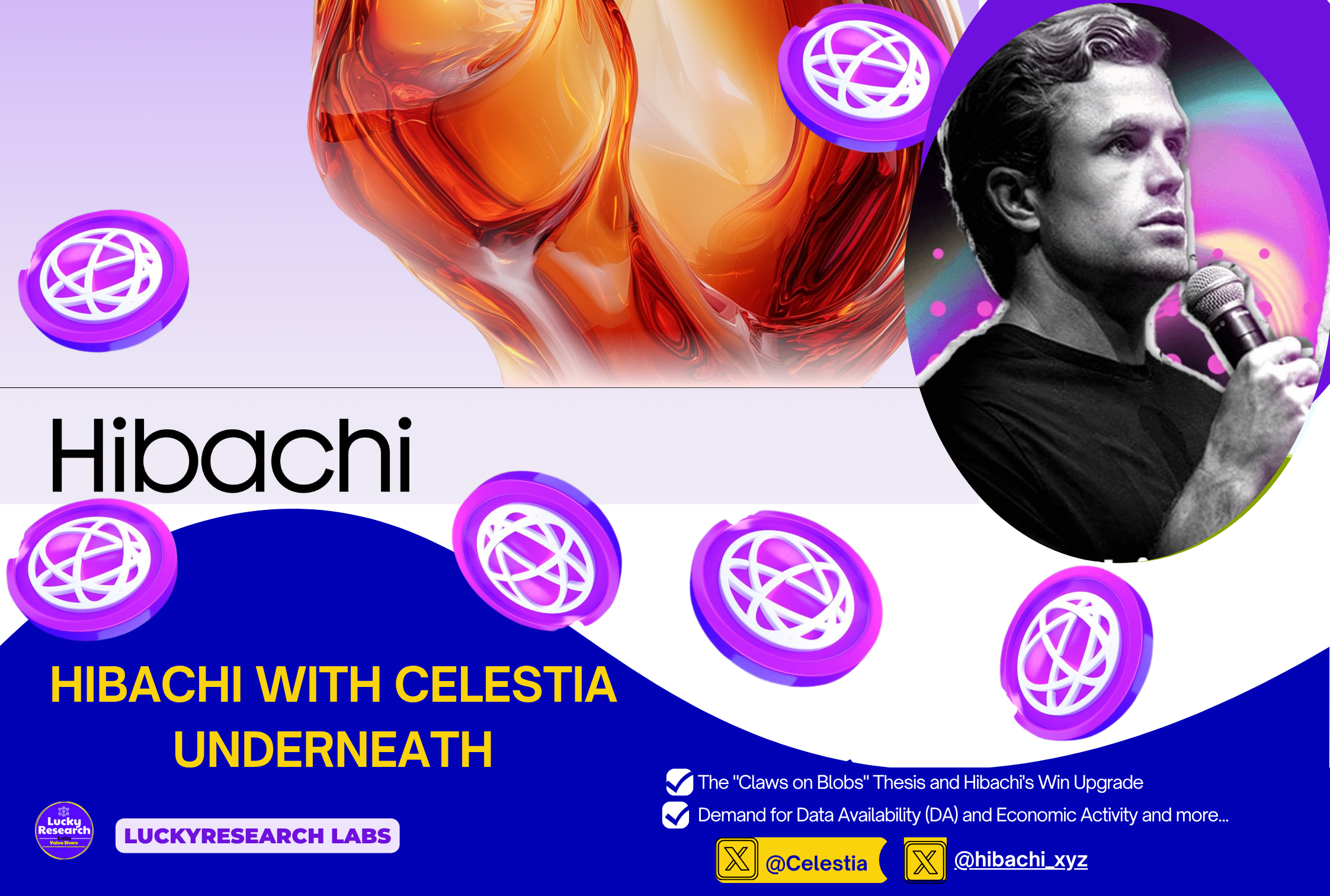🚀 Introduction: From Transparency to Verifiability
The rise of decentralised exchanges (DEXs) has brought greater transparency and openness to financial markets—but it has also exposed users to new forms of risk. In a recent episode dubbed the “Win Incident”, a whale on Hyperliquid lost an estimated $100 million—not to a hack, but to the predictability of their publicly visible trading strategy.
This cautionary tale set the stage for Hibachi’s Win upgrade, a bold new approach to DEX design that blends privacy, verifiability, and performance. Powered by Celestia for modular data availability and Sysinct’s SP1 ZKVM, the Win upgrade aims to reshape how we think about trust, execution, and user protection on decentralised infrastructure.
This post summarises a recent technical deep-dive with Varun (Hibachi & Hashflow) and Uma (Sysinct), exploring the architecture, motivations, and roadmap behind this innovative approach.

🔍 Background: The Claws on Blobs Thesis
The conversation began with reflections on the emergence of on-chain Central Limit Order Books (CLOBs) as a serious contender in DeFi. While AMMs pioneered DEX design, CLOBs like Hyperliquid and Aevo are proving that performance and liquidity aggregation at scale can work on-chain.
This led to the introduction of the "Claws on Blobs" thesis—the idea that rollups and modular architectures like Celestia are especially suited for building performant CLOBs. The Win upgrade is Hibachi’s response to the vulnerabilities seen in current on-chain CLOBs, particularly regarding information leakage and execution transparency.
🔐 The Win Upgrade: Design Goals & Architecture
The Win upgrade was named in memory of the infamous “Win” incident. But instead of just hiding information, it takes a constructive and verifiable approach to privacy.
Core goals include:
-
Maintain high-performance CLOB trading
-
Enable user-level privacy
-
Allow verifiable exits, even if the exchange operator becomes unresponsive
How It Works:
-
Trades are matched on a centralised chain (ARF) to achieve low latency.
-
ZK circuits verify:
-
That trades were signed by user keys
-
That the matching algorithm was followed correctly
-
-
A ZK proof is generated and posted to the L1 or rollup chain where funds reside.
-
Encrypted trade data is stored on Celestia, enabling privacy and exit rights for users, even if the operator disappears.
This design represents a middle ground between full decentralisation and practical performance. According to Varun, it’s a pragmatic trade-off: most users already place some trust in centralised operators (as seen in KYC norms), so combining verifiability with centralised performance hits a sweet spot.
🧩 The VAP Paradigm: Verifiable Apps by Sysinct
Uma introduced the broader design philosophy behind this approach, which Sysinct calls the VAP (Verifiable Application) paradigm. VAPs are centralised apps that behave as if they’re decentralised, thanks to cryptographic proofs.
Benefits of VAPs:
-
Real-time feedback and UX
-
Optional privacy for users
-
Modular and flexible for developers
-
Allows verification of execution without putting everything on-chain
According to Uma, many of these features are impossible to implement in the EVM, due to its synchronous, gas-limited architecture. SP1’s ZKVM gives developers native cryptographic guarantees without the overhead of working directly with SNARKs or STARKs.
🧠 SP1, Celestia & Developer Experience
One of the most impressive parts of the conversation: Varun’s team was able to go from idea to working prototype in just 3.5 months using SP1—without any in-house ZK experts.
That speaks volumes about the developer experience that Sysinct has built with SP1.
Celestia plays an equally important role in this story. By offering a modular data availability layer, Celestia provides the foundation for verifiable and cost-effective storage of encrypted trading data. ZKVMs like SP1 are naturally compatible with Celestia, since they can offload storage needs without sacrificing decentralisation or auditability.
📈 Economic Impact: Data Availability & Real Usage
The team highlighted the growing demand for Data Availability (DA), especially from real applications like CLOBs. According to Varun, Hibachi quickly became one of the top five DA consumers shortly after launch.
Uma pointed out that this is a positive feedback loop: real apps like Hibachi generate sustainable economic activity, which can fund both proving networks and data availability layers. This moves us beyond speculation and into product-market fit for DA and ZK infrastructure.
👁️🗨️ Privacy, ZKVMs, and the Road Ahead
Hibachi is among the few exchanges combining verifiability with privacy. While most blockchains are publicly auditable by default, Hibachi shows how encrypted but verifiable trading is now possible.
Sysinct will continue to focus on default public use cases, but the infrastructure developed for Hibachi now enables serving private app developers as well.
When concerns around decentralisation surfaced—particularly around upgradeable contracts and user data visibility—Varun responded with honesty: Hibachi’s design makes early-stage trade-offs, but prioritises user safety, performance, and verifiability over strict purism.
🔭 Future Roadmaps
For Hibachi:
-
New trading features (TPSL)
-
Python SDK for developers
-
Seamless deposit/withdrawal flow
-
Walt integration (wallet abstraction)
-
Unified account management
For Sysinct:
-
Launching SP1 mainnet
-
Opening up its Prover Network
-
Supporting more use cases across finance, gaming, and private computation
🎯 Conclusion
The Win upgrade from Hibachi is more than just a technical enhancement—it's a paradigm shift in how on-chain exchanges can operate.
By pairing modular DA (Celestia) with verifiable computation (SP1), and embracing the Verifiable App (VAP) model, Hibachi shows that decentralised finance can be:
-
Fast
-
Private
-
Verifiable
As modular infrastructure continues to mature, products like Hibachi may define the future of trading—not just in Web3, but in financial systems as a whole.
Please follow full Live
https://x.com/celestia/status/1937587579635007638?t=7Ntad6U79I21CSvlTa5YHg&s=19



评论 (0)